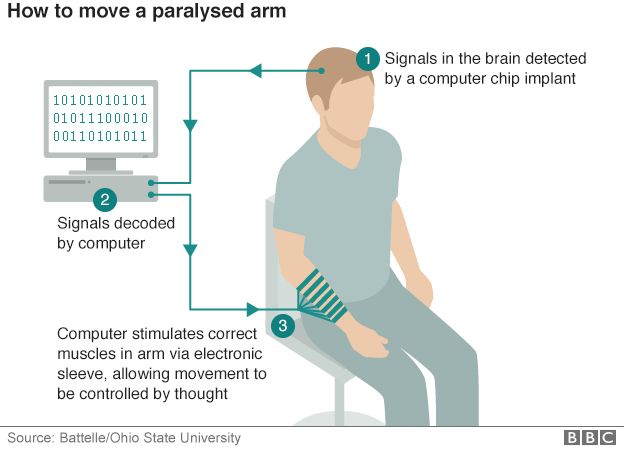Spinal cord stimulator helps paralyzed man move his legs
Spinal cord stimulators (SCS) are FDA-approved neuromodulation implants used to treat chronic neck and back pain. The SCS sends a mild electric current to the spinal cord, masking pain signals before they reach the brain. But what if the electrical signals could be used for other purposes? If an SCS could restore signals across a damaged spinal column, it could restore communication to nerve cells beyond the injury.
Recently, the Mayo Clinic and UCLA received special FDA approval to use an SCS in a clinical trial to restore movement after paralysis… and it worked!
Jered Chinnock was injured in a snowmobile accident four years ago, resulting in three spinal fractures and paralysis from the mid-torso down. He was also the first person enrolled in the Mayo Clinic study. The study combined extensive physical therapy and neurosurgery to implant an epidural SCS that would be able to signal his legs to move.
Before the surgery, Chinnock underwent 22 weeks of physical therapy. The therapy strengthened his muscles and provided Chinnock visual feedback via mirrors showing his lower legs and real-time streaming surface electromyography (EMG) signal so he could think about the movements as they occurred. This was important since he would need to use his thoughts to control his muscles after the SCS was activated.
Muscle activity was recorded with surface EMG electrodes using LabChart and PowerLab, from ADInstruments. Data were sampled at 4 kHz and were exported from LabChart software and analyzed using MATLAB. The EMG data were filtered using a 60-Hz notch filter and a bandpass filter of 20 to 1000 Hz.
“We’re collecting quantitative measures so that we can get some real evidence about what’s changing, if anything, during the rehab,” says Kristin Zhao, Ph.D., co-principal investigator and director of Mayo Clinic’s Assistive and Restorative Technology Laboratory.
Once the therapy session concluded, the spinal cord stimulator was surgically inserted into the vertebrae between the bone and the spinal column. It was an off-the-shelf device by Medtronic. The array of electrodes aligns with nerves in the spinal cord. The computer-controlled device could be adjusted with a remote control.
A short while after the surgery, physical therapy restarted and the results were quite encouraging. According to ScienceDaily, in the first two weeks of post-surgery therapy, Chinnock was able to stand independently, control his muscles to move his legs, and make step-like motions while standing with some support.
The effects of the stimulator were immediate. “The first day they turned it on was almost mind blowing,” stated Chinnock. “Right away, I was able to move my toes.”
The EMG recordings, repeated after the stimulator was activated, are shown below. In the diagram, (A) denotes EMG recordings during the patient’s attempts to volitionally flex his leg muscles. The left-hand side shows that if the applied voltage was too low, the patient was not able to move his leg. The center section shows the threshold voltage needed for motor activity, and the right-hand side of (A) shows the EMG readings when sufficient voltage is used to enable volitional movement.
Sections (B) and (C) in the above diagram show the EMG recordings during the patient’s attempts to move his leg muscles at will. The red plots show the attempts without the spinal stimulator, while the black plots show the results with the spinal stimulator active.
Promising results, promising future
“We’re really excited, because our results went beyond our expectations,” says neurosurgeon Kendall Lee, M.D., Ph.D., principal investigator and director of Mayo Clinic’s Neural Engineering Laboratory. “These are initial findings, but the patient is continuing to make progress.”
The results showed that spinal stimulation can reestablish communication to nerve cells beyond a spinal cord injury and restore voluntary movement in individuals with paralysis. The study also showed that this can be accomplished even years after the initial injury.
“This has really set the tone for our post-surgical rehabilitation – trying to use that function the patient recovered to drive even more return of abilities,” says Zhao.











Comments
To leave a comment, please click here to sign in to your MathWorks Account or create a new one.